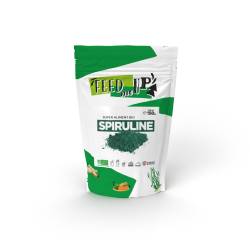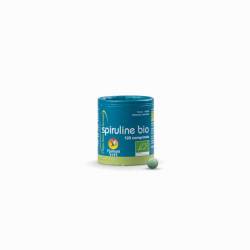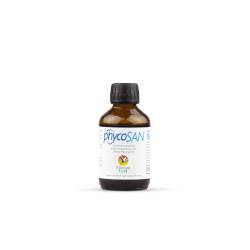Contents
- About spirulina
- Why choose to consume spirulina?
- Proteins and spirulina
- Lipids, carbohydrates and spirulina
- Overview of vitamins, minerals, trace elements with interesting contents
- Vitamin A and spirulina
- Chromium and spirulina
- Iron and spirulina
- Another particularity of spirulina
- Pigments
- chlorophyll
- Phycocyanin
- With spirulina: towards a better immune system and overall well-being
Spirulina has become an essential dietary supplement for several years. Let's take a closer look at what justifies its fame.

About spirulina
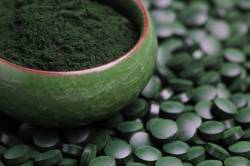
Spirulina, scientifically named Arthrospira platensis , is one of the oldest forms of life on earth. Its existence dates back more than three billion years. The most common variety of spirulina is Spirulina Platensis .
It is now grown in many parts of the world, but beware of its quality. I remind you that it will always be necessary to remain vigilant and to be wary of intensive productions. Production in France continues to increase, but it is up to you, the consumer, to choose the origin of your spirulina carefully. Essence Box guarantees you an optimal quality of its organic spirulina, thanks to a respectful culture born of passion and know-how.
Spirulina owes its name to its shape. It is described as a micro-algae, but it is more specifically... a bacterium! Let's get a microscope and observe! It has the shape of a spiral and does indeed correspond to a bacterium. On the other hand, we will still talk about micro-algae (hoping not to offend the scientific community too much). Why call it something else since it isn't? Well more simply because spirulina is an aquatic organism, capable of oxygen production and photosynthesis (that is to say, it uses sunlight as an energy source, thanks in particular to three pigments : phycocyanin, chlorophyll and carotenoids For readers shocked or reluctant to eat "bacteria", I would remind you that cheese, an icon of French gastronomy, is a good example! A beautiful bloomy rind on Camembert is rich in bacteria and fungi! In the same spirit, probiotics, which have made a golden place for themselves among food supplements, are microorganisms! Therefore, enough fears, let's dare spirulina, because it is full of nutritional benefits and should even find its place in our daily lives. It is also part of nutritional programs to fight against malnutrition in a large number of Third World countries. because it is full of nutritional assets and should even find its place in our daily lives. It is also part of nutritional programs to fight against malnutrition in a large number of Third World countries. because it is full of nutritional assets and should even find its place in our daily lives. It is also part of nutritional programs to fight against malnutrition in a large number of Third World countries.

Why choose to consume spirulina?
We talk a lot about its surprising protein content (more than 60gr per 100gr, more than in fish and meat combined!), with an undeniable quality and proportions of essential amino acids (components of proteins): it contains the 8 essential amino acids (but little methionine). But it is also its concentration of minerals, trace elements and vitamins that have earned it its reputation.
Proteins and spirulina
For consumption intended for needs oriented towards more vitality, improved antioxidant intake, immunostimulating properties, etc., the recommended daily dose to optimize the benefits of spirulina is 6 tablets, or approximately 2g of protein. Compared to the 60-70gr we need every day, the interest here is meager. And it is not essential! For the needs mentioned above, it is not the protein intake in large quantities that will matter, but the vitamins, minerals and trace elements. On the other hand, the use of spirulina in higher quantities will be very interesting to improve the protein intake of vegetarians, vegans, athletes, undernourished and malnourished.
Expert advice :
As said before, for anyone requiring an increase in good quality and highly bioavailable protein intake (vegetarians, vegans, athletes, malnourished, undernourished, anorexic), a daily consumption of at least 10g (avoid exceeding 19g/day) will be necessary. Thanks to this increase in intake, the amount of protein ingested via spirulina will be between 6.8 and 12.9 g per day, i.e. the equivalent of the consumption of a slice of cooked ham (5 g of protein/slice) or a chicken egg (6.2g of protein/egg).
Lipids, carbohydrates and spirulina
The lipid content in spirulina is low and of good quality. The share of alpha-linolenic acid (omega 3) covers 17% of the recommended nutritional intake, for a consumption of 10g of spirulina per day.
As for carbohydrates, the levels are also low, which makes spirulina a non-caloric superfood.

Overview of vitamins, minerals, trace elements with interesting contents
Although spirulina is provided with very diverse vitamins, minerals, trace elements, we will only be interested in those constituting a real asset for a normal consumption of 2 to 5gr of spirulina per day.
If we look closely at the nutritional composition, certain vitamin and mineral contents may seem very high, it must however be borne in mind that the figures are given per 100gr of product. Needless to say, no one will consume 100gr of tablets, and that is not recommended at all.
Vitamin A and spirulina
In the human diet, vitamin A exists in two forms. Retain overall retinol (vitamin A) and carotenoids (pro-vitamin A). Carotenoids are precursors of vitamin A, that is, they are able to convert into vitamin A; they play an antioxidant role by scavenging free radicals. You may have heard of Beta-carotene and lycopene before, well it's pro-vitamin A (there are of course others, such as cryptoxanthin, but lesser known).
Orange fruits and vegetables contain a lot of it, but some other “non-orange” ones can also be good. This is the case, for example, with spinach and lamb's lettuce, for which the chlorophyll (green color) hides the orange pigment (beta-carotene). And this is also the case with spirulina where the blue pigment of phycocyanin takes over the green of chlorophyll and the orange of carotenoids.
Vitamin A plays an essential role in the mechanism of vision (retina), intervenes in the development of the embryo and in the immune system . Also, the consequences of a deficiency are dramatic, since they can lead to irreversible blindness. Vitamin A deficiency is a scourge in developing countries.
Vitamin A (retinol) only exists in foods of animal origin, especially fish livers and oils, as well as animal livers. It is also present in charcuterie (livers and offal), in smaller quantities in certain cheeses (Munster, Brie, Gruyère), in butter and in egg yolk.
It is therefore not so easy to meet vitamin A needs, because food sources are not necessarily pleasant or recommended for everyone: fish oil like organ meats are not welcomed or recommended, as for cold cuts, for public health reasons, it goes without saying that daily consumption is to be banned! The choice of foods containing vitamin A is therefore possible, mainly thanks to fatty dairy products and derivatives (butter). But for vegetarians, vegans, malnourished Third Worlders, the options are few.
Therefore, it should be remembered that spirulina contains mainly carotenoids (pro-vitamin A). The latter are mainly of vegetable origin (although we also find them in certain foods of animal origin, mainly eggs and butter). The best food sources of Beta-carotene, in descending order, are as follows: sweet potato, raw carrot, romaine lettuce, raw spinach, cooked carrot, watercress, dried apricot, pumpkin, fresh apricot, cooked spinach, red pepper, mango, melon, lamb's lettuce, tomato, green pepper, vegetable margarines, butter.
Expert advice:
Total vitamin A requirements (retinol and carotenoids) are 750 micrograms per day for an adult man, 60% of which is beta-carotene. For those whose diet is really varied, balanced, rich in fruits and vegetables, the coverage of needs will be rather easy. But we are well aware that despite a nutritional policy aimed at improving the quality of our plates, the results are not positive enough. Therefore, consuming spirulina can only be beneficial.
For the others, those for whom the intake of food of animal origin is deficient (vegetarians, vegans, malnourished, undernourished), those whose diet is poor and without variety (malnourished, undernourished), the use of spirulina will be indicated. . 10g of spirulina provide as much beta carotene as 125g of raw carrots or 100g of cooked sweet potato. This also helps to understand why spirulina is part of programs to fight against malnutrition.
Important to know: vitamin A belongs to the group of so-called fat-soluble vitamins (soluble in fats = lipids), so the tablets should be taken during a meal containing fat (seasonings such as oil and butter may be sufficient ).
Please note that carotenoid supplementation increases the risk of lung cancer in smokers. Spirulina is therefore not recommended in this case.
Chromium and spirulina
Chromium is an essential trace element for the metabolism of lipids and carbohydrates. It has an insulin potentiating effect and regulates blood sugar.
During diets aimed at losing weight, chromium supplementation is very common, and everyone prescribes it! The doctor, the pharmacist, the dietitian-nutritionist, the naturopath and so on. Spirulina being well endowed with chromium, it is often seen joining the clan of so-called “slimming booster” allies. But be careful, because it is here that the regulations limit us in the claims. Public health authorities authorize the mention of contribution to normal nutrient metabolism, contribution to the maintenance of normal blood sugar, if the food supplement (or food) contains more than 6 micrograms per 100gr. On this side, very good point, since 5 g of spirulina provide 14 micrograms of chromium, or nearly 35% of the ANC. But what about the rest? What is it fair to say?
Expert advice:
Caution will be required, but I remain the bearer of good news: without it being a magic remedy (there is none), spirulina may indeed be indicated in situations where a good functioning of the metabolism will be expected: overweight, diabetes, moderate hyperglycaemia... The interest of its consumption will be evaluated with a health professional.
Iron and spirulina
The iron content in spirulina is particularly interesting. Studies have even shown that the iron in spirulina can be better absorbed than that in meat!
The oh so important and essential role of iron is that of constituent of hemoglobin (respiratory pigments of red blood cells). The iron best absorbed by our body is that of animal origin (meat, fish). Iron of plant origin (lentils for example) is very poorly absorbed. As a result, vegans and vegetarians are often deficient in it.
The risks of anemia are as follows: reduced physical abilities, reduced intellectual abilities, fatigue, reduced resistance to infections, and the list is even longer.
The iron levels in spirulina are exceptional: 4 to 6mg for only 5gr of spirulina. If these figures are abstract for you, remember that a small minced steak of 100gr at 5% fat provides 2.8mg of iron per 100gr, 3 small lamb chops 2.4mg/100gr, a small back of cod (one of the favorite fish of the French) only 0.1mg/100gr, a chicken leg 1.5mg/100gr.
Expert advice:
Iron deficiency is a real public health problem, both in developed and developing countries. This deficiency even appears earlier and earlier, and many pediatricians complain of young children whose iron status is abnormally low. Many women, young girls, are deficient, some athletes too (the resurgence of jumps, for example, leads to microlesions which, repeated, increase iron loss). Among the female sex, many are those who suffer from heavy menstruation, and who are obliged to be supplemented with iron. Others may be deficient after surgery, childbirth, heavy bleeding whatever the origin. If this deficiency is very common in omnivores, so imagine among those who do not consume any animal products! Let's also imagine the damage that this deficiency can cause in young girls with heavy periods who start a vegan diet! Between the problem of iron absorption, intake and loss, managing one's iron status is… hell… In this sense, you will have understood, dear reader, spirulina plays a crucial role.
The average nutritional need for iron is 11mg/day for men and adolescents, it is 11 to 16mg for women: 11mg for women and adolescents whose menstrual losses are low or for young girls not menstruating, 11mg/day for postmenopausal women, 13mg/day for adolescents (12 to 17 years old) with heavy menstrual losses and 16mg/day for women and girls over 18 with heavy menstrual losses.
Therefore, given the difficulty in maintaining constant iron intake, the use of spirulina at least 5g/day is essential. The ideal is to start a cure over one or two months, then to reduce gradually. In addition, do not hesitate to plan several cures per year. For those whose diet excludes any animal product (vegan), spirulina should be taken daily, quantity to be determined with a health professional. For women whose periods are strong, do not hesitate to consume more spirulina on the days when bleeding begins. Get advice from your practitioner to control the quantities that will be suitable for you.
Important to know: the iron in spirulina will be better absorbed during a meal containing a food rich in vitamin C (kiwi, red fruits, citrus fruits).
Warning : if you are already supplemented with iron, spirulina will not be recommended. Always ask your doctor for advice.

Another particularity of spirulina
Pigments
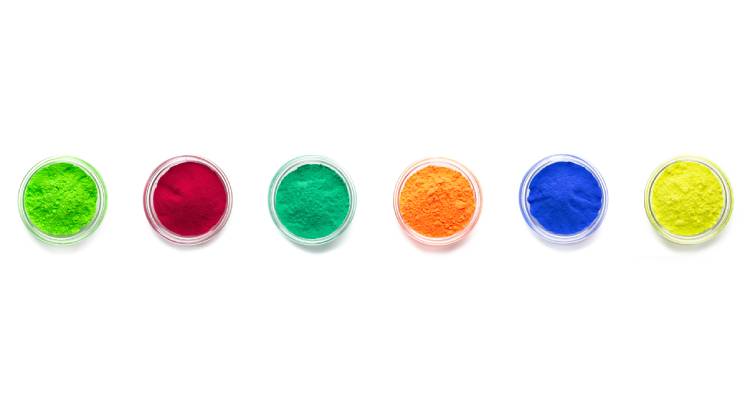
Spirulina is very rich in pigments, it contains more than fifteen, but we will only discuss the three essential ones here: carotenoids , orange pigments (explained above in the description of Vitamin A), chlorophyll , pigment green, and phycocyanin , a blue pigment. The combination of these three pigments gives spirulina its unique color: a dark emerald-khaki.
chlorophyll
Analyzes show that 5g of spirulina can contain up to 40mg of chlorophyll. But how is this an advantage?
Chlorophyll, a green pigment, can help strengthen the circulatory system and would stimulate the production of hemoglobin and red blood cells in people with anemia, by bringing oxygen to the blood. It would also have anti-inflammatory, antioxidant and immuno-stimulating properties.
Phycocyanin
Phycocyanin (blue pigment characteristic of spirulina. Its rate can exceed 12%, and this figure is very important because it contributes to the extraordinary character of spirulina.
Phycocyanin has the reputation of being a powerful antioxidant, more powerful than vitamin C and vitamin E.
It strengthens the immune defences, it promotes blood oxygenation, promotes the production of red blood cells, has anti-inflammatory properties. For athletes, it has another advantage: it increases the ability to maintain prolonged physical effort. Some studies even show anti-allergic, hepatoprotective and anti-tumor actions. In this regard, a study is even underway to measure the activity of phycocyanin as a care support in oncology. The results should be published in 2023.
Another significant aspect of phycocyanin: its potentially neuroprotective role. This role is still being studied but would already seem to show a prophylactic effect in the onset of neurodegenerative diseases, Alzheimer's and Parkinson's in particular. To be continued, therefore, because the beneficial effects continue to be the subject of serious scientific research.

With spirulina: towards a better immune system and overall well-being
Spirulina helps prevent a weakening of the immune system and maintain good immune activity . Immune weakening can be linked to: weekly or even daily intense physical effort, lack of sleep, stress, physical inactivity. Spirulina supplementation will therefore be indicated. And do not hesitate either, at the approach of the winter periods or in prevention of an infectious reactivation (herpes labialis for example) to plan a cure of spirulina (2gr/day).
After collecting testimonials from patients who have followed spirulina cures, here are the benefits felt:
- energy boost
- better muscle recovery
- reduction of hormonal acne and menstrual pain
- healthier hair and nails
- better intestinal transit
- better overall condition
The testimonies collected correspond to doses of spirulina ranging from 2 to 5g per day (> or = 10g for athletes).
Health vigilance
- Spirulina can change the color of the stool, without this being cause for concern.
- As explained above, spirulina, rich in carotenoids and vitamin K, should be avoided in smokers and when taking anti-coagulants.
- Spirulina can cause digestive disorders (in this case, reduce the dosage, then increase it again very gradually). If the troubles persist, stopping spirulina will be advised.
- In case of phenylketonuria, hemochromatosis, autoimmune diseases, taking immunosuppressants, spirulina will not be suitable.
Linked products
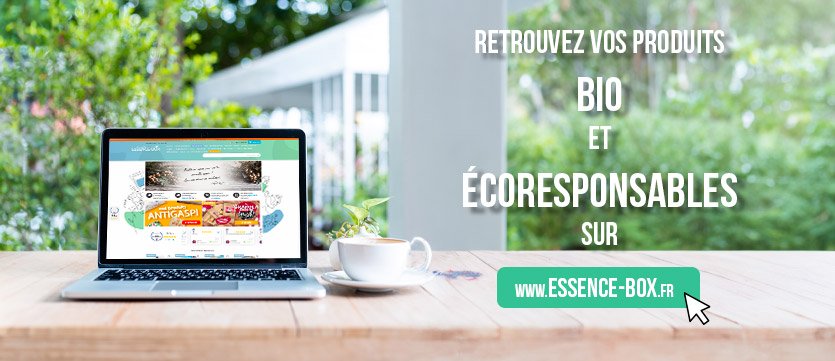


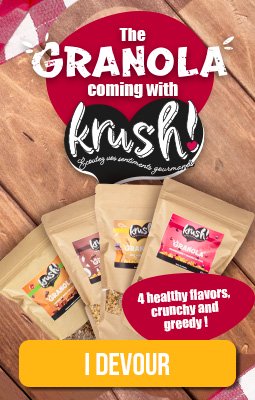
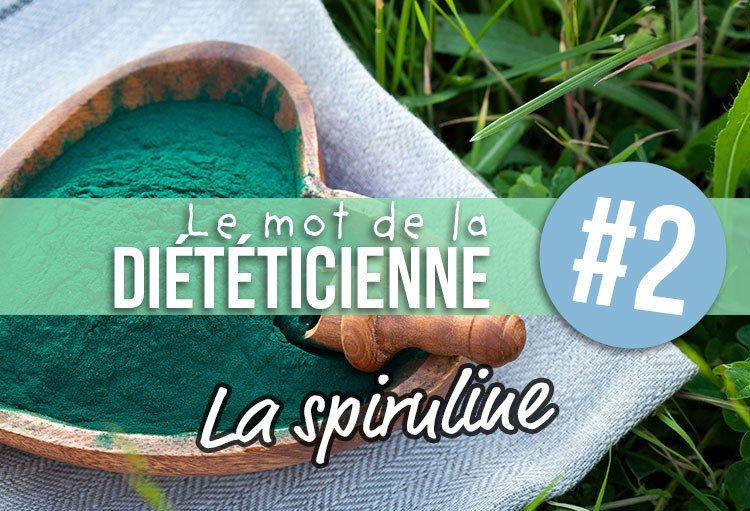
 By Flora Massanella - Diététicienne
By Flora Massanella - Diététicienne
